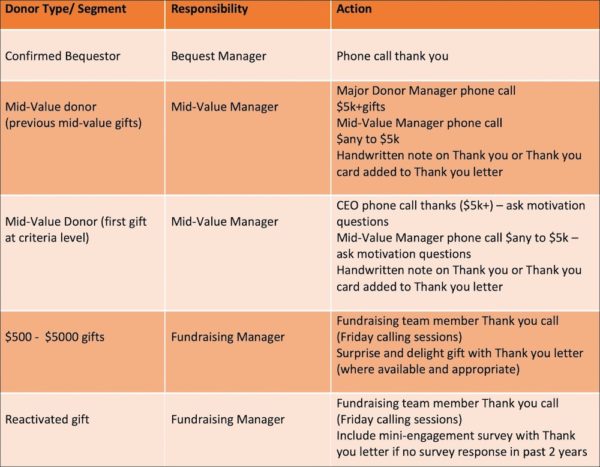Think for a moment what it’s like to be a donor right now during this pandemic crisis…
- You are afraid — for your own health, your economic future, for your family and loved ones, for the world.
- You want to help. After all, you are a donor, and that’s what you do!
- You are getting a lot of emergency fundraising about the current situation — probably more than you could possibly respond to. At the same time, some of your favorite organizations have gone silent on you.
- You want to do the right thing and donate where you can make a difference, but it’s hard to tell what’s your best choice.
How do we as fundraisers give our donors what they need most in these confusing and difficult times?
You show them the love.
You go all in on Donor Love.
Here are five things you can do that will boost your donors’ confidence and make them glad they give to your organization during this time of crisis. These things will not only make your donor feel better, but they’ll increase the chance that your donor will keep being your donor — through this crisis and long after.
- Say thank you every time you interact with donors
Thanking for a donation is obvious. But let me challenge you to take a look at your standard donation thank you letter (maybe you call it your receipt or acknowledgment letter), website donation auto response, and standard email donation acknowledgment. Do they use the words THANK YOU? Do they use the words THANK YOU more than once? You might be surprised. I know I am when I see how often the message meant to thank donors doesn’t actually say thank you!
This is the most important time ever to ramp up the thankfulness.
Even better, make sure those thank you letters are very specific to the impact your donor has had.
Now consider how you can say thank you even more. Thank you for calling. Thank you for your email. Thank you for your feedback (even when they give feedback you find challenging). Build this into phone scripts and email templates as standard.
Your donor needs to hear it. Again and again. Especially now — and what you do now will have outsized impact.
- Handwrite a note on their receipt / thank you letter
Show your donor that a real human acknowledges the wonderful thing they did. This really comes to life when you not only hand-sign thank you letters, but also add a smiley face or quick handwritten note.
- Call them to say thank you
This is another powerful way to show your donor that a real human acknowledges the wonderful thing they did. Thank you calls are really impactful. You can also simply set the task of trying to call and thank every donor, once in the year. It doesn’t have to be in response to a specific gift. Have an example of the impact they have had and call and thank them for being part of that impact and acknowledge how long they have been giving.
Check out Amnesty Australia’s brilliant all staff Thank You Day. I should warn you that this video may make you want to get everyone involved in thanking your donors, which is an incredible way to support fundraising within your organisation.
- Give them opportunities for feedback, questions and sharing
A Supporter Connection Survey is a great way to do this — and it has heaps of added benefits. (Find out more about this tool by reading Here’s One Easy Tool That Transforms Your Fundraising).
A donor care letter is another way to do this. (Read about how to do one of these at A Great Way to REALLY Thank Your Donors.)
Give them a way to communicate with you on your appeal response forms such as a comments or feedback box. Literally say, “I’d love to hear any feedback you have about how I communicate with you” or “If you have any questions about the impact you are having on X, please let me know below” or “I’d love to know why you chose to give to support X today, please let me know.”
And here’s something courageous leaders do: Give donors a way to get in touch personally – my favorite is providing your email address (not a generic one but your actual email address) and direct phone number in your next appeal letter. Don’t worry — you won’t have hundreds of donors calling you, but the few who do are engaged and worthy of your time.
- Implement an acknowledgment strategy
The following table is an example of how you can get started with an acknowledgment strategy. It starts with the key donor groups this charity has, ranked by priority. It assigns a person to be responsible for their piece of donor love. And it details the standard action to be taken by the person responsible when a donation is made.
This organisation uses multiple team members and multiple tactics to show the love. Most importantly, it is programmed so it happens.
Every interaction is captured in their database so it can be tracked. The Mid and Major Donor teams use the opportunity as part of their engagement and prospecting, the Bequest Manager uses the opportunity to stay in touch, the Fundraising Manager uses the opportunity to help their team engage with donors.
They also use a surprise and delight approach, which sees them gather together small gifts that are produced as part of their wider fundraising and communications activity (such as premiums from returned acquisition packs or appeals, leftover merchandise and gifts from events) as well as some purposely produced items they know donors love.
The team is given the opportunity to use their discretion to add these small gifts of thanks to thank you letters as a way of surprising and delighting donors in an appropriate and cost-effective way.

Discover how you can connect more with your donors, grow your fundraising income, and master your career — even when times are tough. Join The Fundraisingology Lab for extraordinary training, resources, cheat-sheets, and a worldwide community of fundraisers who will lift your spirits and transform your career.
Related Posts:










